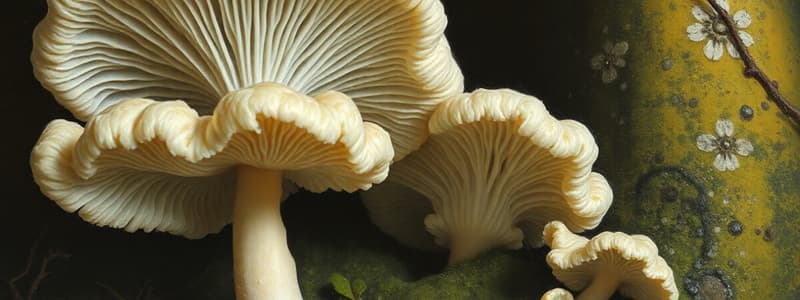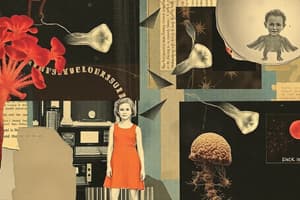Podcast
Questions and Answers
What structure forms from the fusion of a conidium or hypha with a trichogyne in Neurospora crassa?
What structure forms from the fusion of a conidium or hypha with a trichogyne in Neurospora crassa?
- Ascus (correct)
- Heterokaryon
- Perithecium
- Protoperithecium
In the life cycle of Neurospora crassa, how many ascospores are typically produced from one mature ascus?
In the life cycle of Neurospora crassa, how many ascospores are typically produced from one mature ascus?
- Four
- Ten
- Eight (correct)
- Sixteen
What is the role of the protoperithecium in the sexual reproduction of Neurospora crassa?
What is the role of the protoperithecium in the sexual reproduction of Neurospora crassa?
- To house the diploid zygotes
- To develop into immature female fruiting bodies (correct)
- To produce asexual spores
- To initiate the germination of ascospores
What is formed when vegetative hyphae from different mycelia anastomose?
What is formed when vegetative hyphae from different mycelia anastomose?
During which stage of Neurospora crassa's life cycle does meiosis occur?
During which stage of Neurospora crassa's life cycle does meiosis occur?
Flashcards are hidden until you start studying
Study Notes
Neurospora crassa
- Neurospora crassa is a bread mold, a type of fungus with mycelia composed of interwoven filaments called hyphae
- Hyphae tips can produce asexual spores called conidia, which can germinate into new mycelia
- Vegetative hyphae are partitioned into sections, each containing multiple haploid nuclei
- Hyphae from different mycelia can fuse, creating a heterokaryon, a mix of nuclei within a shared cytoplasm
- Sexual reproduction in Neurospora crassa is determined by two mating types, represented by alleles A and a.
- Sexual reproduction involves the union of cells from opposite mating types.
- Specialized regions of the mycelium produce protoperithecia, from which trichogynes (receptive filaments) extend.
- Conidia/hyphae from the opposing mating type fuse with trichogynes, undergoing multiple karyokineses and fertilizing many female nuclei.
- The fertilized nuclei form diploid zygotes within elongated sacs called asci
- Each zygote undergoes meiosis, producing four nuclei, followed by a mitotic division to create four pairs of nuclei, ultimately maturing into eight ascospores
- Mature perithecia (fruiting bodies) can house over 100 ascospores
- The Neurospora crassa life cycle diagram (Fig. 6-5) depicts both sexual and asexual reproduction, from germinating conidia/hyphae to the formation of mature asci and germinating ascospores
- Diagram labels include conidia, protoperithecium, mature ascus, and perithecium, illustrating the transition from asexual to sexual reproduction and resulting ascospore formation
Studying That Suits You
Use AI to generate personalized quizzes and flashcards to suit your learning preferences.



